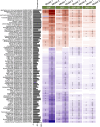The association between the gut microbiome and 24-h blood pressure measurements in the SCAPIS study
- PMID: 40624247
- PMCID: PMC12234806
- DOI: 10.1038/s43856-025-00980-x
The association between the gut microbiome and 24-h blood pressure measurements in the SCAPIS study
Abstract
Background: There is mounting evidence supporting the role of the microbiota in hypertension from experimental studies and population-based studies. We aimed to investigate the relationship between specific characteristics of the gut microbiome and 24-h ambulatory blood pressure measurements.
Methods: The association of gut microbial species and microbial functions, determined by shotgun metagenomic sequencing of fecal samples, with 24-h ambulatory blood pressure measurements in 3695 participants and office blood pressure was assessed in multivariable-adjusted models in 2770 participants without antihypertensive medication from the Swedish CArdioPulmonary bioImage Study.
Results: Gut microbiome alpha diversity was negatively associated with diastolic blood pressure variability. Additionally, four microbial species were associated with at least one of the 24-h blood pressure traits. Streptococcus sp001556435 was associated with higher systolic blood pressure, Intestinimonas massiliensis and Dysosmobacter sp001916835 with lower systolic blood pressure, Dysosmobacter sp001916835 with lower diastolic blood pressure, and ER4 sp900317525 with lower systolic blood pressure variability. Moreover, office blood pressure data from a subsample without ambulatory blood pressure measurements replicated the association of Intestinimonas massiliensis with systolic blood pressure and Dysosmobacter sp001916835 with diastolic blood pressure. Species associated with 24-h blood pressure were linked to a similar pattern of metabolites.
Conclusions: In this large cross-sectional analysis, gut microbiome alpha diversity negatively associates with diastolic blood pressure variability, and four gut microbial species associate with 24-h blood pressure traits.
Plain language summary
High blood pressure is a major risk factor for heart disease and stroke. Recent research suggests that bacteria in the gut may influence blood pressure, but more studies are needed. In this study, we analyzed data from 3695 people in Sweden who wore a 24-h blood pressure monitor and provided stool samples for gut microbiome analysis—a method that identifies the types and abundance of microorganisms in the sample. We found that people with greater gut bacteria diversity had more stable blood pressure. Additionally, four specific bacterial species were linked to blood pressure levels; three were associated with lower blood pressure, while one was linked to higher levels. These findings suggest that gut bacteria may play a role in regulating blood pressure. Future research could explore whether changing the gut microbiome might help prevent or treat high blood pressure.
© 2025. The Author(s).
Conflict of interest statement
Competing interests: The authors declare the following competing interests: N.N., A.C.E. and J.B.H., and H.B.N. are employees of Cmbio. The funders had no role in study design, data collection and analysis, decision to publish, nor preparation of the manuscript. J.Ä. has received lecture fees from Novartis and AstraZeneca, and served on advisory boards for AstraZeneca and Boerhinger Ingelheim, all unrelated to the present paper. J.S. reports stock ownership in Anagram kommunikation AB and Symptoms Europe AB, unrelated to the present study. All other authors declare no conflicts of interest in connection with this study.
Figures


References
-
- Avery, E. G. et al. The gut microbiome in hypertension: recent advances and future perspectives. Circ. Res.128, 934–950 (2021). - PubMed
-
- Ufnal, M. et al. Trimethylamine-N-oxide: a carnitine-derived metabolite that prolongs the hypertensive effect of angiotensin II in rats. Can. J. Cardiol.30, 1700–1705 (2014). - PubMed
Grants and funding
- ERC-STG-2018-801965, ERC-CoG-2014-649021, ERC-STG-2015-679242/EC | EU Framework Programme for Research and Innovation H2020 | H2020 Priority Excellent Science | H2020 European Research Council (H2020 Excellent Science - European Research Council)
- 2019-01471; 2018-02784; 2018-02837; 2021-03291/Vetenskapsrådet (Swedish Research Council)
- 2023-0687; 20200711 (M.O-M.); 20180343, 20210357; 20200173; 20190526/Hjärt-Lungfonden (Swedish Heart-Lung Foundation)
- NNF20OC0063886/Novo Nordisk Fonden (Novo Nordisk Foundation)
- LUDC-IRC 15-0067/Stiftelsen för Strategisk Forskning (Swedish Foundation for Strategic Research)
LinkOut - more resources
Full Text Sources
Medical

